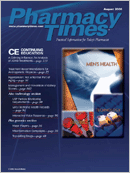Publication
Article
Pharmacy Times
Pharmacist Catch of the Month
Unnecessary Lovenox
A patient was admitted for shortnessof breath and lower-extremity edema.The patient was immediately started onLovenox (enoxaparin) 110 mg sq q 12 h.A Doppler was ordered to rule out deepvein thrombosis. The Doppler was negative,and the result was reported the nextmorning. None of the interns, however,realized at the time that the Lovenoxshould be stopped.
During medicine rounds, a pharmacistdiscovered the oversight and stoppedthe Lovenox (12 hours after the patienthad been found to be negative). The discontinuationhas resulted in less bleedingrisk, less unnecessary medication,and huge cost savings (the acquisitioncost for the Lovenox 100-and 30-mgsyringe was $67.90 per dose).
Pramlintide Overdose
A patient was admitted with diabeticketoacidosis and was immediatelystarted on an insulin drip in the intensivecare unit (ICU). The next day thepatient began eating, and Symlin (pramlintideacetate) 45 units sq tid wasordered. The medication was nonformulary,but the patient had brought a vial.
The physician demanded that themedication be given in the ICU, withoutpharmacist verification. Two doses weregiven before a pharmacist caught theorder with the incorrect dosage. Thepatient was nauseated from the highdoses and received promethazine.
The pharmacist changed the order to45 mcg per dose, which equated to 7.5units per dose. The patient's nurses andthe physician were informed, and themedication error was forwarded to theInstitute for Safe Medication Practices.
Spiking Systolic BP
A patient in a skilled nursing facilityhas a past medical history of cerebrovascularaccident, anemia of chronicdisease, diabetes mellitus, and hypertension.When she was admitted to thefacility in March 2006, her blood pressure(BP) was well-controlled, and shewas on 4 medications (hydralazine,isosorbide dinitrate, amlodipine, andlisinopril). Her hemoglobin and hematocrit(H/H) readings were 10.7 and 32.2,and she was receiving epoetin 40,000units weekly with ferrous sulfate (FeSO4)300 mg tid by gastrostomy tube. Herindexes were consistent with normocyticand normochromic anemia.
In May 2006, nurses noted that thepatient was having systolic BP readings>200 mm Hg. The physician increased hermedications, and her BP would respondfor a couple of days and then spike again.
On June 9, a pharmacist ordered achemistry and complete blood countpanel. Her H/H levels were found to be14.5 and 45.4, with normal indexes. Thepharmacist immediately stopped theepoetin and FeS04.
The patient's BP is being aggressivelycontrolled with 5 medications and isbeing monitored daily. The rapid increasein hemoglobin has been associatedwith hypertension. The treatmentis symptomatic.







